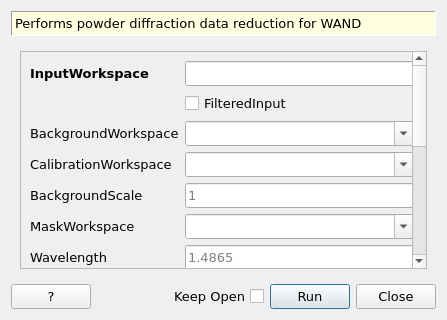\(\renewcommand\AA{\unicode{x212B}}\)
WANDPowderReduction v1¶

WANDPowderReduction dialog.¶
Summary¶
Performs powder diffraction data reduction for WAND
See Also¶
Properties¶
Name |
Direction |
Type |
Default |
Description |
|---|---|---|---|---|
InputWorkspace |
Input |
str list |
Mandatory |
The main input workspace[s]. |
FilteredInput |
Input |
boolean |
False |
Specifies whether the input workspace was obtained from event filtering. |
BackgroundWorkspace |
Input |
The background workspace to be subtracted. |
||
CalibrationWorkspace |
Input |
The calibration (vanadium) workspace. |
||
BackgroundScale |
Input |
number |
1 |
The background will be scaled by this number before being subtracted. |
MaskWorkspace |
Input |
MaskWorkspace |
The mask from this workspace will be applied before reduction |
|
Wavelength |
Input |
number |
1.4865 |
Wavelength to set the workspace (A) |
Target |
Input |
string |
Mandatory |
The unit to which spectrum axis is converted to. Allowed values: [‘Theta’, ‘ElasticQ’, ‘ElasticDSpacing’] |
XMin |
Input |
dbl list |
A comma separated list of the XMin for every spectrum. (Optional) |
|
XMax |
Input |
dbl list |
A comma separated list of the XMax for every spectrum. (Optional) |
|
LogBinning |
Input |
boolean |
False |
Use logarithmic binning. If false use constant step sizes. |
NumberBins |
Input |
number |
1000 |
Number of bins to split up each spectrum into. |
NormaliseBy |
Input |
string |
Monitor |
Normalise to monitor or time. Allowed values: [‘None’, ‘Time’, ‘Monitor’] |
MaskAngle |
Input |
number |
Optional |
Phi angle above which will be masked. See MaskAngle for details. |
OutputWorkspace |
Output |
Mandatory |
Output Workspace |
|
Sum |
Input |
boolean |
False |
Specifies either single output workspace or output group workspace containing several workspaces. |
Description¶
This algorithm performs powder diffraction data reduction for WAND² with calibration, monitor normalization and background subtraction. The CalibrationWorkspace will most likely be a vanadium and will correct for the detector sensitivity. The data can be normalized by monitor count or time. The output workspace can be saved to various formats with SaveFocusedXYE.
It is recommenced to load WAND data with LoadWAND. This algorithm will work on data loaded with LoadEventNexus or the grouped output from FilterEvents.
MaskAngle¶
The MaskAngle option will mask any out-of-plane (phi angle) detector larger than this value using MaskAngle. This can help with peak sharpness by removing regions where there is large peak broadening due to the divergent beam. The example below using MaskAngle of 10.

Usage¶
Silicon powder
silicon =LoadWAND('/HFIR/HB2C/IPTS-7776/nexus/HB2C_26506.nxs.h5')
vanadium=LoadWAND('/HFIR/HB2C/IPTS-7776/nexus/HB2C_26509.nxs.h5')
WANDPowderReduction(InputWorkspace=silicon,
CalibrationWorkspace=vanadium,
Target='Theta',
NumberBins=1000,
OutputWorkspace='silicon_powder',
Sum=False)

Silicon powder to Q over limited range
silicon =LoadWAND('/HFIR/HB2C/IPTS-7776/nexus/HB2C_26506.nxs.h5')
vanadium=LoadWAND('/HFIR/HB2C/IPTS-7776/nexus/HB2C_26509.nxs.h5')
WANDPowderReduction(InputWorkspace=silicon,
CalibrationWorkspace=vanadium,
Target='ElasticQ',
XMin=4.5,
Xmax=6.25,
NumberBins=500,
OutputWorkspace='silicon_powder_q',
Sum=False)

Silicon powder to D spacing
silicon2=LoadWAND('/HFIR/HB2C/IPTS-7776/nexus/HB2C_26507.nxs.h5')
vanadium=LoadWAND('/HFIR/HB2C/IPTS-7776/nexus/HB2C_26509.nxs.h5')
WANDPowderReduction(InputWorkspace=silicon2,
CalibrationWorkspace=vanadium,
Target='ElasticDSpacing',
NumberBins=1000,
OutputWorkspace='silicon_powder_d_spacing',
Sum=False)

Background subtraction
silicon =LoadWAND('/HFIR/HB2C/IPTS-7776/nexus/HB2C_26506.nxs.h5')
vanadium=LoadWAND('/HFIR/HB2C/IPTS-7776/nexus/HB2C_26509.nxs.h5')
# Create fake flat background, constant 10
bkg=CreateWorkspace(DataX=[1.487,1.489]*silicon.getNumberHistograms(),
DataY=[10]*silicon.getNumberHistograms(),
NSpec=silicon.getNumberHistograms(),
UnitX="Wavelength",ParentWorkspace=silicon)
WANDPowderReduction(InputWorkspace=silicon,
CalibrationWorkspace=vanadium,
BackgroundWorkspace=bkg,
Target='Theta',
NumberBins=1000,
OutputWorkspace='silicon_powder_background',
Sum=False)
# Scale background by 50%
WANDPowderReduction(InputWorkspace=silicon,
CalibrationWorkspace=vanadium,
BackgroundWorkspace=bkg,
BackgroundScale=0.5,
Target='Theta',
NumberBins=1000,
OutputWorkspace='silicon_powder_background_0.5',
Sum=False)

Using multiple input workspaces
si1 = LoadWAND('/HFIR/HB2C/IPTS-22745/nexus/HB2C_320234.nxs.h5')
si2 = LoadWAND('/HFIR/HB2C/IPTS-22745/nexus/HB2C_320235.nxs.h5')
va0 = LoadWAND('/HFIR/HB2C/IPTS-23858/nexus/HB2C_320259.nxs.h5')
# single ws
WANDPowderReduction(
InputWorkspace=si1,
CalibrationWorkspace=va0,
Target='Theta',
NumberBins=1000,
NormaliseBy='Time',
OutputWorkspace=f'si1_reduced',
Sum=False,
)
# single ws
WANDPowderReduction(
InputWorkspace=si2,
CalibrationWorkspace=va0,
Target='Theta',
NumberBins=1000,
NormaliseBy='Time',
OutputWorkspace=f'si2_reduced',
Sum=False,
)
# merged ws - single (summed) output ws
WANDPowderReduction(
InputWorkspace=[si1, si2],
CalibrationWorkspace=va0,
Target='Theta',
NumberBins=1000,
NormaliseBy='Time',
OutputWorkspace=f'si_reduced',
Sum=True,
)
# merged ws - group output ws
WANDPowderReduction(
InputWorkspace=[si1, si2],
CalibrationWorkspace=va0,
Target='Theta',
NumberBins=1000,
NormaliseBy='Time',
OutputWorkspace=f'si_reduced',
Sum=False,
)

Categories: AlgorithmIndex | Diffraction\Reduction
Source¶
Python: WANDPowderReduction.py
